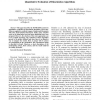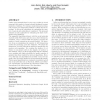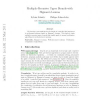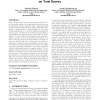IEEEVAST
2010
14 years 2 months ago
2010
Optimization problems are typically addressed by purely automatic approaches. For multi-objective problems, however, a single best solution often does not exist. In this case, it ...
ICFHR
2010
14 years 2 months ago
2010
This paper describes the ICFHR 2010 Contest for quantitative evaluation of binarization algorithms. These algorithm are applied to synthetic images of modern pdf documents with noi...
WWW
2011
ACM
14 years 2 months ago
2011
ACM
Online social networks have become very popular in recent years and their number of users is already measured in many hundreds of millions. For various commercial and sociological...
TSP
2011
14 years 2 months ago
2011
—This work proposes a blind adaptive reduced-rank scheme and constrained constant-modulus (CCM) adaptive algorithms for interference suppression in wireless communications system...
CORR
2010
Springer
14 years 2 months ago
2010
Springer
We consider an opportunistic spectrum access (OSA) problem where the time-varying condition of each channel (e.g., as a result of random fading or certain primary users' activ...
CDC
2010
IEEE
14 years 2 months ago
2010
IEEE
Abstract-- We consider reinforcement learning, and in particular, the Q-learning algorithm in large state and action spaces. In order to cope with the size of the spaces, a functio...
CORR
2011
Springer
14 years 2 months ago
2011
Springer
We develop a new analysis for the length of controlled bad sequences in well-quasi-orderings based on Higman’s Lemma. This leads to tight multiply-recursive upper bounds that re...
WWW
2011
ACM
14 years 2 months ago
2011
ACM
Once information retrieval has located a document, and information extraction has provided its contents, how do we know whether we should actually believe it? Fact-finders are a ...
WWW
2011
ACM
14 years 2 months ago
2011
ACM
The clustering coefficient of a node in a social network is a fundamental measure that quantifies how tightly-knit the community is around the node. Its computation can be reduce...
WWW
2011
ACM
14 years 2 months ago
2011
ACM
Many real-life graphs such as social networks and peer-topeer networks capture the relationships among the nodes by using trust scores to label the edges. Important usage of such ...




